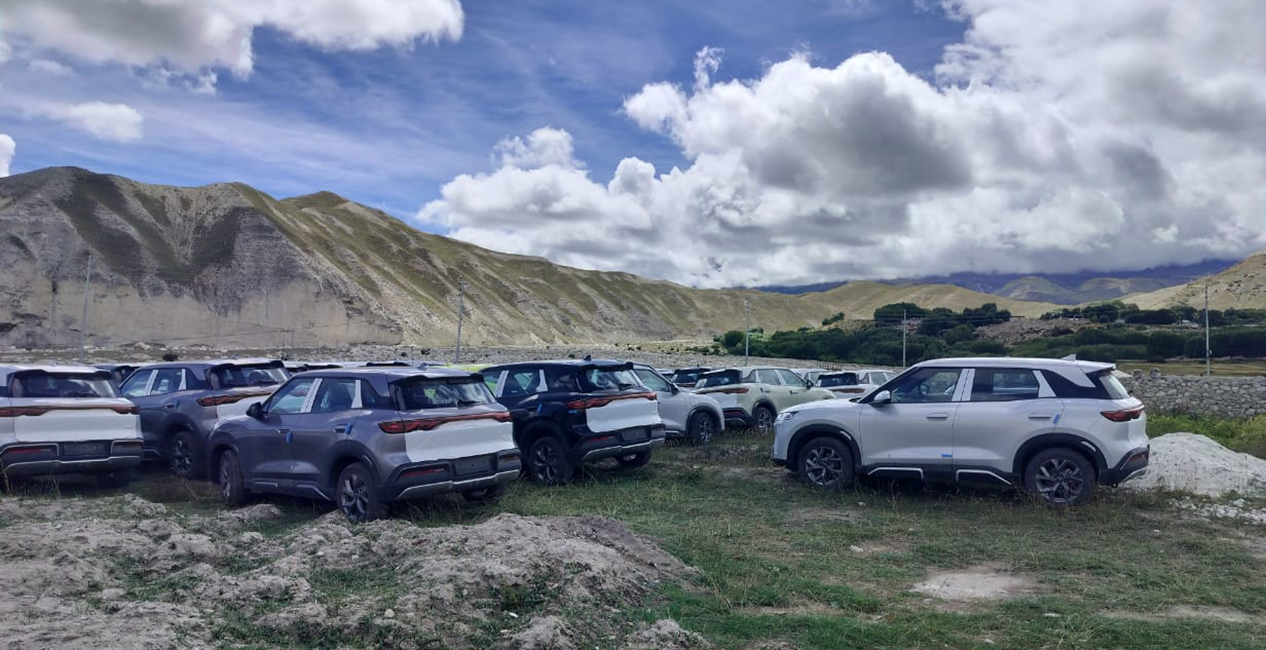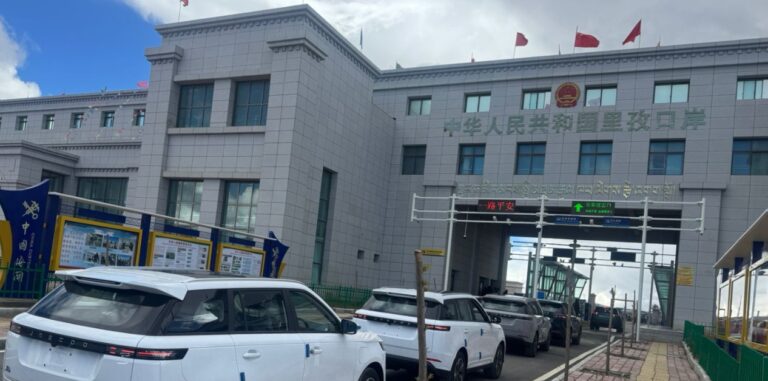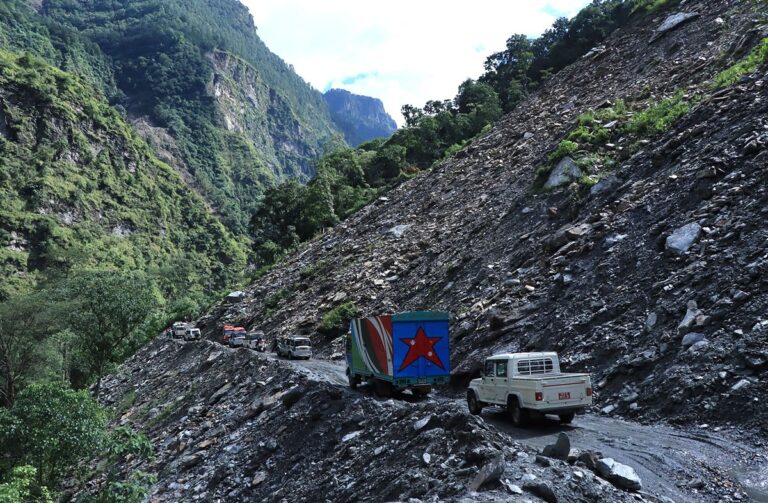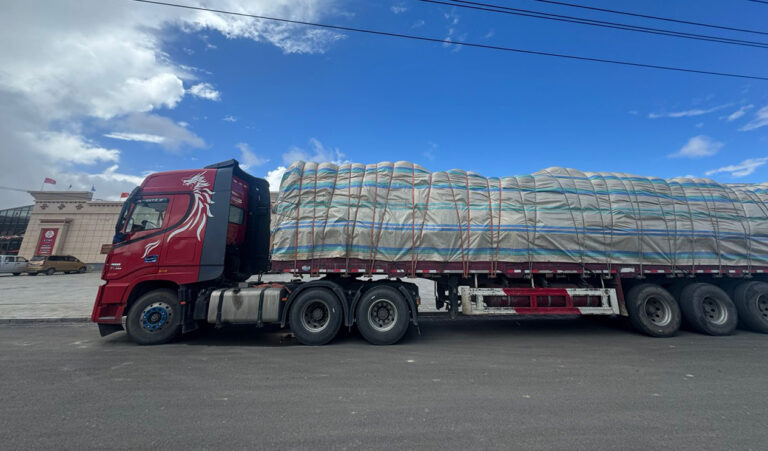
Nepal–China trade begins via Korala as Tatopani and Rasuwagadhi borders remain blocked.

KATHMANDU: With the closures of Tatopani in Sindhupalchok and Rasuwagadhi in Rasuwa, a new border checkpoint at Korala has been opened for trade with China.
The Korala checkpoint, located along the China and Mustang’s Lomanthang Rural Municipality border, is now operational for commercial purposes for the first time.
This Mustang checkpoint is situated 14 kilometers from the main Nepal-China gateway at Korala, on the Nepali side in a place called Nechung, where a customs office has been established to handle inspection and clearance work.
A Nepali Armed Police Force border security office is also located there. A four-room building has been converted into a customs office. While customs clearance is being conducted in Nechung, goods entering from China are still processed through the Korala checkpoint.
A flood on June 28 washed away the bridge connecting Nepal and China at Rasuwa. Hundreds of containers loaded with goods, parked at the dry port in Timure, were swept away in the floodwaters.
The customs office was completely destroyed. Since then, trade between Nepal and China through that checkpoint has been completely halted.
The old and historically significant checkpoint for trade with China is Tatopani in Sindhupalchok. Trade through this checkpoint has slowed over the past decade due to frequent disruptions.
Landslides in 2014, the 2015 earthquake, and the Bhotekoshi flood of 2020 have often forced Tatopani to close. Import and export activity that used to thrive via Tatopani has dwindled. Floods at Bhotekoshi often wash away bridges and roads, while landslides block roads, leaving Tatopani continuously unreliable. As an alternative, Rasuwagadhi had emerged as a secondary gateway.
From September 15, the Korala checkpoint became fully operational for the first time.
Although Rasuwagadhi is somewhat farther from Kathmandu than Tatopani, small and medium traders used it to import and export goods. However, severe flooding has now rendered this checkpoint unusable.
The Chinese side has started reconstruction of the destroyed infrastructure, while the Nepali government has requested that infrastructure on the Nepal side also be completed to resume trade.
Goods imported through Tatopani usually reach Kathmandu within 10 days. The same goods, if transported via the sea route through Birgunj Customs, take around 40 days. Goods brought through Kerung–Rasuwagadhi take between 20 days to one month. The longer it takes to transport goods, the higher the shipping costs.
Because Tatopani allowed for quicker delivery, most traders preferred using this checkpoint. The alternative was Kerung–Rasuwagadhi. However, when both trade checkpoints with China were closed ahead of major festivals, traders themselves pushed for the Mustang Korala checkpoint to be opened. From September 15, the Korala checkpoint became fully operational for the first time.
Severe cold, no infrastructures
Situated at an altitude of 4,600 meters above sea level, Korala is an extremely cold region. Even now, temperatures there drop below freezing during evenings and mornings.
Due to the severe cold, vehicles often fail to start, so a customs office has been set up in Nechung to handle operations, according to Bishnu Prasad Bhusal, Chief District Officer of Mustang. He explains, “Korala is extremely cold. Vehicles won’t start. Running trade operations during winter is very difficult. If infrastructure is built in Nechung, customs work can be carried out regularly throughout the year.”
On the Chinese side, all necessary infrastructure near the Korala border has already been constructed. On the Nepal side, the immigration office has been built and inaugurated but cannot operate due to the extreme cold, Bhusal says.

Korala checkpoint on the China side. Photo: Sundar Kumar Thakali /RSS
A four-room building has been converted into a customs office. The Customs Department only recently installed its customs management software, known as the ASYCUDA system. Currently, 11 staff members are working at the customs office.
The Nepal Rastra Bank has amended its unified circular, allowing banks to issue letters of credit (LCs) for imports through the Mustang customs office. Nepali traders can now open LCs via banks to import goods through Korla. However, no bank branches are yet present within the customs office compound.
There is no yard to store containers with incoming goods. For now, traders are parking containers and electric vehicles wherever space is available. Since electric vehicles reaching Nechung cannot be driven to Pokhara without recharging, traders are building a charging station on their own initiative.
“To operate Korla checkpoint permanently, proper office infrastructure must be built. The road toward Myagdi needs upgrading. On the Jomsom side, 100 kilometers of road remain unpaved. Bridges are under construction on the Upper Mustang Road section,” says Chief District Officer Bhusal.
Kali Gandaki Corridor could boost trade
The road in Myagdi is narrow. According to Gokarna Karki, President of the Pokhara Chamber of Commerce and Industry, the road near Rupse Falls is difficult to navigate and occasionally at risk of landslides. Once the Kali Gandaki Corridor is completed, trade through this checkpoint is expected to receive additional support.
Previously, only Nepalis from Upper Mustang used the Korala checkpoint to travel to and from China. There were no commercial import-export activities. Although various initiatives had been made to operate the checkpoint regularly, none had achieved practical results.
When traders realized there was little possibility of bringing goods through the two traditional checkpoints, they began pushing for Korala to be used.
Automobile traders, in particular, had bookings for vehicles to be available during the Dashain festival, but it became impossible to import Chinese vehicles via Tatopani and Rasuwa. Consequently, they opted for the Korala route.
Containers carrying clothes, fruits, and electronics have also started moving toward Korla. As of September 20, customs clearance at Nechung has been completed for 209 electric vehicles and 107 containers carrying goods, according to Kishor Bartaula, Director of the Customs Department. He adds that the customs clearance process has generated Rs 344.7 million in revenue.

Vehicles crossing a landslide at Siruwari, Raghuganga Rural Municipality–2, Myagdi, on the Beni–Jomsom–Korala road of the Kali Gandaki Corridor. Photo: Santosh Gautam/RSS
History of intermittent openings
The Korala checkpoint became operational only because traders took the initiative. “A checkpoint operates only when traders want it to. Various initiatives had been made earlier to run the checkpoint, but they were unsuccessful. Now it has succeeded because traders wanted it,” says Bishnu Prasad Bhusal, Chief District Officer of Mustang.
In September 2023, then-Prime Minister Pushpa Kamal Dahal made diplomatic efforts to open Korala during his visit to China. Dahal, who spent a week in China starting September 21, undertook diplomatic initiatives to open the Korala checkpoint located on the China and Mustang’s Lomanthang Rural Municipality border.
After his return, the Chinese Embassy sent a diplomatic note asking the Nepali side to start efforts to open Korala. About one and a half months later, from November 13, 2023, the checkpoint was opened exclusively for residents of Upper Mustang. It is now operational for commercial trade.
The Korala checkpoint was fully closed by the Chinese side during the COVID-19 pandemic. However, closures are not new.
In the 1960s, Tibet was annexed by China, and the Khampa rebels used Nepali territory to stage uprisings. Because of these uprisings, movement through Korala was strictly regulated starting 1975. Until 2001, there were no restrictions, but from 2002, China fenced the area and restricted movement except during trade fairs.
Every year, two inter-country trade fairs were held at Korla, allowing Mustang residents temporary access to China.
Recently, China completed infrastructure on its side of the border. With the Rasuwagadhi–Kerung checkpoint unlikely to reopen immediately, China had no hesitation in allowing Korala to operate.
Officials from the Myagdi and Pokhara Chambers of Commerce continuously pressured the Nepali government to establish a customs office at Korla to regularize trade. Tsesi Nherbu Gurung, Chairperson of Lomanthang Rural Municipality, was also actively involved in these efforts for a long time.
Plans to make Korala operational year-round
“We need to build permanent structures at the Mustang customs office so that this checkpoint can operate throughout the year. For this, we will provide both cooperation and pressure,” says Gokarna Karki, President of the Pokhara Chamber of Commerce and Industry.
The federal government itself is taking initiatives to reopen Tatopani, the traditional checkpoint for trade with China. The road leading to Nepal via Tatopani had collapsed at several places, causing the checkpoint to be blocked.

A truck carrying goods arriving at Korala (China side) from China. Photo: RSS
It has now become operational from Monday. According to Sagar Ghimire, Senior Vice President of the Himalayan Cross-Border Trade Association, nearly 1,000 containers loaded with goods destined for Nepal are lined up on the road all the way to Lhasa, waiting to pass through Tatopani.
Because roads were blocked, some traders were manually carrying sacks of fruits and goods meant for Dashain festival to Kathmandu. According to trader Ghimire, much of this involved clearing landslides while transporting fruits mainly imported from China.
Kumar Shrestha, Chairperson of Tatopani Rural Municipality–2, says that the road from Tatopani to Nepal was blocked in three places. “There was a large landslide at Kodari.
Near Ghatte Khola, the road had collapsed. In Daklang, approximately 70 meters of the road was damaged in three spots,” Shrestha explains.
Local residents, led by Shrestha, submitted a memorandum to Minister of Physical Infrastructure and Transport, Kulman Ghising, requesting immediate repair of the road.
Ghising instructed the Department of Roads to repair and reopen the route without delay. The Road Division Office in Charikot had been continuously working for a week to reopen the road toward Tatopani.
“After continuous efforts, the road was reopened on Monday afternoon,” says Suraj Maharjan, engineer at Charikot Road Division Office.
“Five places were blocked. In Daklang, three locations were damaged. At the 112-kilometer mark, the road had completely washed away. A major landslide occurred at Kodari. Repairs at all these points have now been completed.”
Even with the road reopened, traders are not confident that all goods via Tatopani will reach Kathmandu before Dashain.
“Only 30–40 vehicles get customs clearance daily. Even with the road open, it cannot be guaranteed that all containers will arrive in Kathmandu before Dashain,” Ghimire notes.